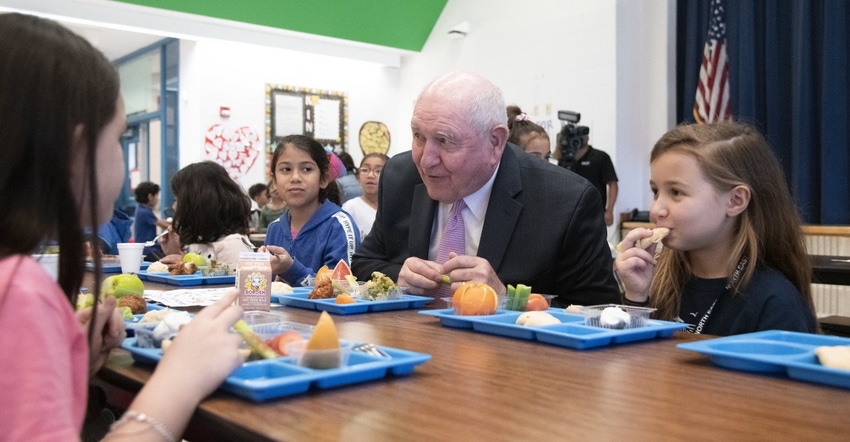American Heart Assn. warns against proposed changes as unwarranted while School Nutrition Assn. has welcomed previous changes.

Touted as a way to put local school and summer food service operators “back in the driver’s seat of their programs” and offer school nutrition professions more flexibility to appeal to students’ preference and reduce food waste, the U.S. Department of Agriculture announced additional proposed rule changes to its school and summer meal programs.
“Schools and school districts continue to tell us that there is still too much food waste and that more common-sense flexibility is needed to provide students nutritious and appetizing meals. We listened and now we’re getting to work,” said Secretary of Agriculture Sonny Perdue.
In a statement, USDA shared the school meals proposed rule would continue to ensure children receive wholesome, tasty meals that provide the nutrition they need to grow and thrive, while offering increased flexibilities for local school districts to serve children food they will want to eat, by:
Allowing local schools to offer more vegetable varieties, while keeping plenty of veggies in each meal;
Making it easier for schools to offer school lunch entrees for a la carte purchase, thereby reducing food waste;
Providing schools options to customize meal patterns to best serve children in different grades or smaller schools who eat together;
Supporting a more customized school breakfast environment by letting schools adjust fruit servings and making it simpler to offer meats/meat alternates, ultimately encouraging breakfast options outside the cafeteria so students can start their day with a healthy breakfast; and
Shifting to a performance-focused administrative review process that is less burdensome and time consuming, which would increase collaboration with operators to improve program integrity.
During a roundtable featuring leaders of the School Nutrition Assn. (SNA), Perdue announced the regulations on Jan. 17.
“SNA is eager to review the proposed changes, discuss them with our members and share their feedback with USDA,” said SNA president Gay Anderson. “We are grateful for USDA’s ongoing dialogue with school nutrition professionals and desire to ensure school meal programs operate smoothly to benefit students.”
However, the American Heart Assn. (AMA) said it is “adamantly opposed” to the rule and said it was concerned about several aspects of the proposal. Specifically, the proposal allows for the reducing the amount of fruit required at breakfast for meals served outside the cafeteria. Schools could now provide as little as a half cup of fruit, a 50% reduction from current requirements, AMA said. It also removes the requirement that schools serve grains at breakfast and schools could meet the standards by serving meat and a no-grain product.
AMA also shared concerns in changing the vegetable subgroup requirements so that schools are no longer required to serve as many red and orange vegetables and legumes. “Instead, schools could serve more potatoes and other starchy, often fried, vegetables,” AMA said.
Changes to the a-la-carte also pose issues, AMA said. “While entrees and side dishes sold as part of the reimbursable meal are required to meet the school meal nutrition standards, these standards are averaged across the weekly menu. This gives schools the flexibility to occasionally serve a food that does not meet nutrition standards on its own but is balanced by healthier sides. If these foods are allowed to be sold more frequently in a-la-carte, there is no requirement that children select a balanced meal. Children could, for example, purchase three slices of pizza in the a-la-carte line instead of purchasing a nutritionally balanced, reimbursable lunch that contains a slice of pizza, salad, and fruit,” AMA said.
“While the USDA claims these changes are necessary to mitigate food waste, studies show that food waste has either remained the same or decreased since the updated school nutrition standards. There are several other effective strategies to reduce food waste in schools, such as giving students more time to eat; putting recess before lunch; marketing healthy foods to kids; and involving students in meal planning, none of which jeopardizes the health of our children,” AMA said.
USDA also proposed another rule with customer-focused reforms to the Summer Food Service Program (SFSP), which serves more than 2.6 million children during the summer months, when they are at higher risk of food insecurity and poor nutrition because they do not have access to school meals. The summer feeding rule offers operators more local control to better serve children by:
Providing more flexibilities in choosing meal offerings, meal service times, and allowing children to take certain nonperishable food items offsite;
Granting tested and proven flexibilities that make it easier for sponsors and sites to participate by reducing paperwork and streamlining the application process for high-performing, experienced operators;
Balancing program integrity and flexibility with stronger monitoring to help sponsors maximize their resources; and
Clarifying performance standards and eligibility requirements for sites.
About the Author(s)
You May Also Like




.png?width=300&auto=webp&quality=80&disable=upscale)
